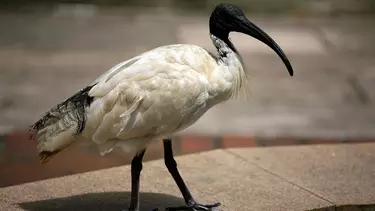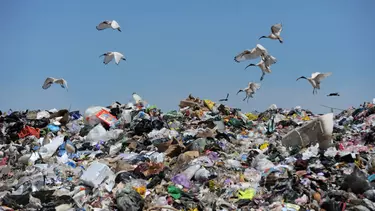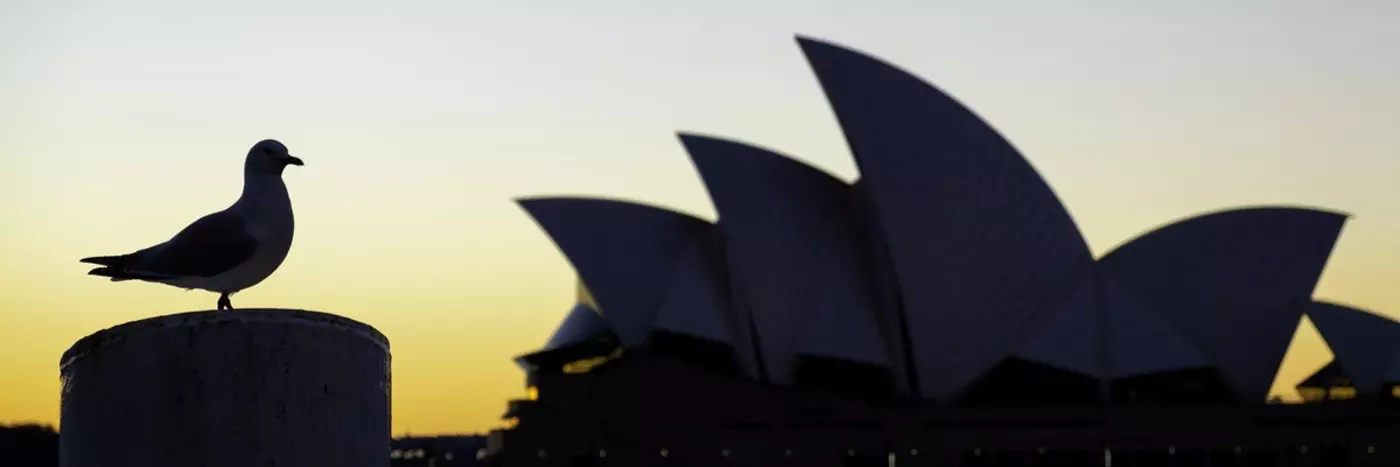Spare a thought for the birds of Circular Quay
For decades, ibises and seagulls have been adjusting their behaviour around the tourists and workers of the city. So what happens when all the humans go missing?
Imagine parachuting down towards Sydney Harbour. You notice the big things first. The Harbour Bridge and the Opera House, swarmed by air traffic as the Silver Gulls stake out their lunches below. Then, a little closer, the ferries (some of them already leaking), the busses, the rideshares milling around the entrance to Circular Quay. Get closer again and notice the littlest icons of the city: the opal card dispensers, the workers dressed halfway between office and activewear and—their beaks submerged like dipsticks into the mouth of every bin—the Australian White Ibis.
Today’s Sydney, amidst a city-wide lockdown, is markedly different for our avian lunchtime companions. No impromptu dates or make-out sessions on the steps of the Opera House, no tourists funnelling from the passenger terminal, no fries peeking from discarded McDonald’s sleeves. The birds are still here, but are they hungry? The answer involves how Sydney has grown over the past seventy years, and the various urban and ecological shifts in NSW that have brought new species of bird to the CBD.
History
“In the 1950s, 60s, 70s, if you were a birdo and you saw an Ibis you would have run up to your mates and said ‘let’s go look at this bird’. If it’s in town, you get excited,” says Dr. John Martin, a Research Scientist at the Taronga Institute of Science and Learning, whose research partially concerns the urban adaptiveness of native birds. Traditionally, the Ibises were massed in the wetlands of greater NSW, with occurrences in the city limited. Ongoing dry conditions and human practices have degraded these landscapes and pushed a large portion of these crafty, adaptive birds towards Sydney.
But this Great Ibis Schism has resulted in a substantial transformation in character. “In the western wetlands of New South Wales, you can't get within 100 metres of them. They don't want anything to do with people,” Dr. Martin continues. The city Ibis, by contrast, not only tolerates but actively solicits from pedestrian traffic in the city. A phenomenal example of their adaptive capacity, these Ibises have incorporated people as an active and passive food supply, typified by the common image of the scavenging bin chicken perched on the CBD’s navy coloured receptacles. This kind of urban adaptation is not limited to the Ibis, indeed Dr. Martin is currently engaged in a study of Sydney’s Sulphur-crested Cockatoos, which have been observed opening bins with their beaks to scavenge for food.

Lockdown dining
While there is limited data tracking the performance of urban birds in the absence of foot traffic, analogous data can help us speculate on their fate during COVID. A 2016 study of the ibises during rainy days examined their eating habits when pedestrian traffic was low. “No one's having a picnic or putting rubbish in the bin and the parks are empty. What does the Ibis do? They're all eating worms. So they just transition that day to a different natural food source,” says Dr. Martin.
A radio tracking study in 2010 found that only a small minority of Ibis are really attached to their precise section of the city — a lazy group of birds Dr. Martin compares to Sydneysiders tied to their local cafes. The vast majority of the Ibis are willing to travel to eat where necessary. At the risk of increasing the number of penalty infringement notices issued in the City of Sydney, some ibises were observed to fly over 35 kilometres from the city to the Eastern Creek to feed at landfill sites, which are still abundant with household rubbish. While consumptive patterns for people have changed, the outcome remains the same and the Ibises are willing to travel.

What of the seagull? Like the Ibis, the Opera House’s unofficial mascot the Silver Gull has spent the last 18 months adapting to the loss of its pedestrian food source. In ordinary times, they’re “clever opportunists and scavengers,” a behaviour that has allowed them to thrive all around coastal Australia. Their approach has been described as “garbivory” by Dr. Heidi J Auman, an Adjunct Lecturer from the Institute for Marine and Antarctic Studies at the University of Tasmania. It’s their capacity for “generalist behaviour”, feeding on numerous types of food and thriving in many environments, that contributes to their robustness even at the height of COVID lockdown.
For Dr. Martin, this capacity to adapt is crucial for birds in urban environments. The Ibis particularly has persevered despite wider wetland degradation in NSW through moving to the city. “If people aren’t providing food they will just go to a park, they’ll fossick through the leaf litter, they’ll go to a pond to probe through the muddy substrate or they’ll fly further afield to a natural wetland or go to the landfill. There’s lots of options.” Similarly, the Silver Gull is capable of quickly reverting to natural food sources. Dr. Auman describes their omnivor-ish preference for “fish, insects, crustaceans, small vertebrates like fish, frogs and mammals, eggs of other birds, and some plants.” They’ve also been observed to behave like the Ibises, targeting worms on rainy days.
This Ibis’ presence in Sydney gives us pause to consider the birds that cannot transition so easily.
There are crucial differences, however. While the Silver Gull is common to the coastline and has persevered through all manner of urban development, the Ibis has been pushed here. Their ongoing presence in Sydney highlights that not all birds are thriving under manmade conditions. “The Ibis is actually a conservation messenger that's flying the flag to say, hey, there's a problem in western New South Wales that you might be overlooking,” says Dr. Martin. Among waterbirds, the Ibis is unique for its adaptivity. Other Australian waterbirds, like the threatened Pink-eared Duck, are incapable of shifting to urban environments, and ongoing dry conditions and corrosive human practices continue to degrade their natural conditions. This Ibis’ presence in Sydney gives us pause to consider the birds that cannot transition so easily.
The Silver Gull on the other hand has stepped beyond mere adaptation, it has ambitions towards becoming the apex predator of Circular Quay. It’s not uncommon to sit on the steps of the Opera House and find your lunch pecked from your hands by a particularly ambitious gull. For Dr. Auman, this aggressive — and dare we say — greedy behaviour is learned, grounded in feedback cycles from pedestrians feeding the birds. “They have learned that fortune favours the bold!” Dr Auman says. “Feeding them only encourages this aggressive behaviour.”
What now?
For these birds, a pedestrian-free Sydney is no trouble: a chance to spread the wings and explore strange landfills, to make new friends and find out what’s for dinner on the other side of the Red Rooster line. This may come as a disappointment to Sydney’s bird watchers, who have been hoarding stale bread in anticipation for a return to the city. Dr. Martin gives some advice here: use restraint. If you choose to engage them with food, you must recognise many like minded Sydneysiders are doing the same. Less is more, and be sure to respect signage in parks asking you not to. Dr. Auman also asks pedestrians to look out for birds that may need our assistance, as the Gulls sometimes get trapped with fishing hooks embedded in them or wrapped in fishing line. As an alternative to food donations, just “call your local animal rescue hotline if you find a sick or injured bird”.
Alternatively, you may be better off holstering that Quarter Pounder and letting the camera eat first. The Big City Birds app is an easy pathway to Citizen Science, allowing anyone with a smartphone to contribute vital data on how these birds navigate a constantly changing urban environment. Information on where they’re nesting, what you’re feeding them or what they’re naturally foraging, will help us understand how and why these birds have been able to adapt.
With each change in the city’s environment, these birds have found new ways and opportunities to thrive. When we put lids on our bins, they learn to open them. When we stop showing up, they improvise. So for the bird sympathetic among us — stay those hands! The Ibis and Silver Gulls have no need for charity. Their capacity to thrive should give us pause to reflect on the birds that haven’t or can’t (and while you’re at it, schedule a trip out to the wetlands — just remember to keep your distance and respect their environment). The city dwellers know, where there’s a will (and a beak) there’s a free lunch.

